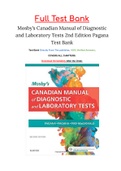Exam (elaborations)
Mosby’s Canadian Manual of Diagnostic and Laboratory Tests 2nd Edition Pagana Test Bank
Mosby’s Canadian Manual of Diagnostic and Laboratory Tests 2nd Edition Pagana Test Bank Instant delivery (Printed PDF)
To clarify, this is the test bank, not the textbook. You get immediate access to download your test bank. You will receive a complete test bank; in other words, all chapters wil...
[Show more]
Preview 4 out of 134 pages
Uploaded on
January 10, 2022
Number of pages
134
Written in
2021/2022
Type
Exam (elaborations)
Contains
Questions & answers
mosby’s canadian manual of diagnostic and laboratory tests 2nd edition pagana test bank
mosby’s canadian manual of diagnostic and laboratory tests 2nd edition pagana
mosby’s canadian manual of diagnos
By: sherprichodko • 3 months ago
By: rosewill84 • 2 year ago
By: Examsonline • 2 year ago
Hello dear, what is the problem with this test bank ?
By: Examsonline • 2 year ago
Hello dear, what is the problem with this test bank ?
By: pilarvalero • 2 year ago
By: azorclaudia • 2 year ago
By: Examsonline • 2 year ago
Hello dear, what is the problem with this test bank ?
$25.99
100% satisfaction guarantee
Immediately available after payment
Both online and in PDF
No strings attached
Full Test Bank




